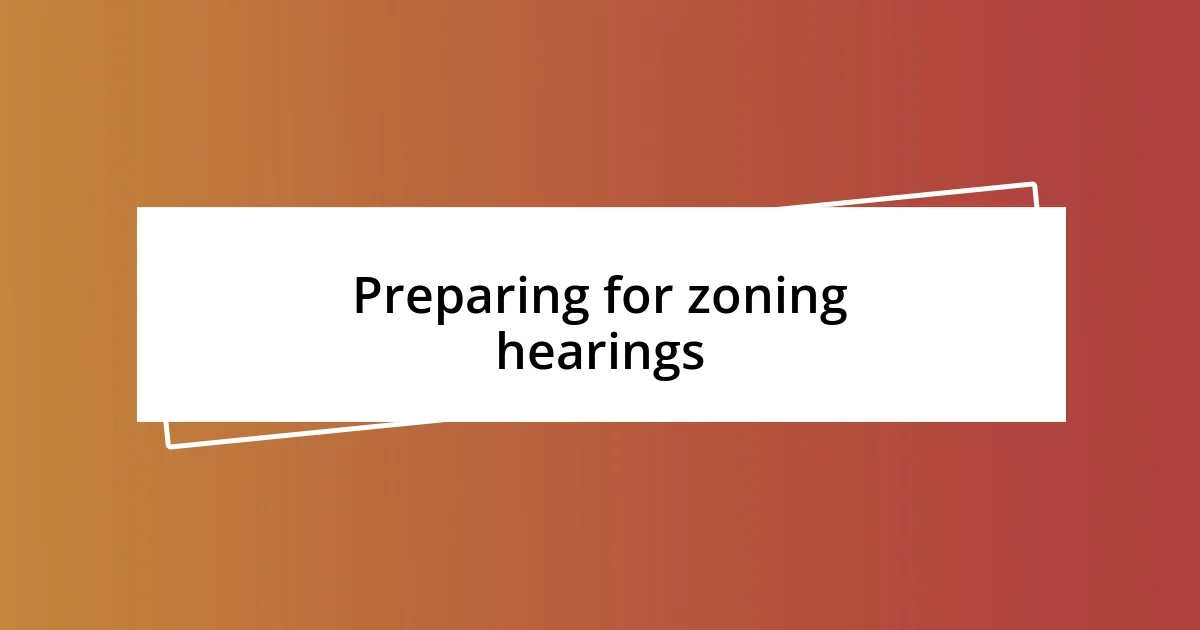Key takeaways:
- Understanding zoning regulations is crucial for development; they enhance community planning and public safety.
- Effective communication with zoning officials fosters collaboration and helps navigate complex regulations.
- Adapting projects to zoning requirements encourages creativity and innovation, transforming limitations into design opportunities.

Understanding zoning regulations
Understanding zoning regulations can feel like navigating a maze, but it’s crucial for anyone looking to develop property or start a business. I vividly remember the first time I dove into these regulations—my head spun with unfamiliar terms and legalese. How was I supposed to know that a “mixed-use zone” could allow both residential and commercial spaces?
It’s important to recognize that zoning is not just bureaucratic jargon; it’s a framework designed to shape our communities. When I realized that these regulations impact everything from the height of buildings to the type of businesses allowed, it shifted my perspective. Have you thought about how much they influence your neighborhood? Understanding the ‘why’ behind these regulations can unveil the logic of urban planning and community development.
At times, I found myself frustrated by restrictions that felt arbitrary. However, I later discovered that these rules often exist for public safety, environmental conservation, and the overall welfare of the community. Knowing this made each frustrating encounter a bit more palatable, helping me appreciate the balance that zoning regulations strive to maintain. So, while it may seem tedious, take the time to explore your local zoning laws—they often reveal a larger narrative about the spaces we inhabit.

Researching local zoning laws
Researching local zoning laws was one of the most enlightening yet daunting tasks I undertook. Initially, I felt overwhelmed by the sheer volume of documents, especially when zoning codes varied not just by state but even by municipality. To tackle this, I broke down my research into manageable chunks, focusing first on the city’s zoning map. I was amazed at how a simple image could unlock so much information about what could be built where and under what conditions.
Next, I began reaching out to local zoning offices—those friendly faces behind the bureaucratic curtains. Although my first call was awkward, asking questions I thought might seem silly, I quickly learned that these staff members genuinely want to help the public understand zoning. They turned out to be an invaluable resource for me; they not only provided clarity on regulations but also guided me on potential development opportunities in my area, which I found incredibly encouraging.
To further illustrate my journey, I created a comparison table below that highlights different aspects of local zoning laws I encountered during my research. It became a handy reference as I navigated my project, and I encourage anyone else embarking on this path to consider documenting their findings in a similar manner.
| Aspect | My Experience |
|---|---|
| Resolution Process | Time-consuming, but rewarding with clear guidance. |
| Community Impact | Deeply felt; regulations shaped my approach to development. |
| Available Resources | Local zoning office and online archives proved invaluable. |

Analyzing zoning maps effectively
Examining zoning maps is like peering into a crystal ball that reveals the potential—and limitations—of a property’s future. When I first studied a zoning map, I felt a twinge of excitement. It was like uncovering the mystery of what could be built where. Each color, line, and symbol held secrets about land use. Deciphering these elements, however, required a careful eye and a bit of patience.
To navigate zoning maps effectively, consider the following points:
– Understand the Color Codes: Each color typically represents a different zoning category, like residential or commercial. Familiarizing yourself with these can save you time and help avoid misunderstandings.
– Pay Attention to Boundaries: These delineate zones and can indicate where regulations change. I learned that even small shifts in boundaries can drastically alter development possibilities.
– Check Layers and Overlays: Some maps include special overlays that impose additional regulations, such as flood zones or historical districts. Noticing these can be critical for compliance.
– Utilize Digital Tools: Many municipalities offer intuitive online mapping tools that let you zoom in and out, revealing intricate details—this was a game changer for my planning phase.
The reality is, zoning maps can sometimes feel overwhelming. I remember staring at one, certain I was missing vital information. It was only after a couple of hours with the map in front of me, cross-referencing notes from the zoning office, that the patterns began to emerge. I found this meticulous effort both challenging and oddly satisfying—a puzzle piece finally falling into place. After all, taking the time to truly analyze these maps opens up a clearer vision of what’s possible for your project and, ultimately, your community.

Navigating zoning permit processes
Navigating the zoning permit process felt like embarking on an intricate journey where each step had its importance. I still vividly recall the day I submitted my first permit application—I was buzzing with anticipation but also a bit anxious. Would I get it right? I learned quickly that attention to detail is crucial here; any oversight could lead to delays. That’s why I meticulously double-checked every line of the application to ensure that I met all the requirements.
As I delved deeper, I found that communication was my most powerful tool. I established a friendly rapport with the zoning officials, which proved invaluable later on. One afternoon, I received a call from one of them who was willing to walk me through the approval process step-by-step. This kind of direct engagement not only eased my concerns but made me feel more connected to the community. It’s truly remarkable how a simple conversation can clear the fog surrounding complex permits.
Through my experience, I realized that the permit process often feels like a marathon rather than a sprint. There were moments of frustration, especially when the unexpected popped up, like requiring additional documents or getting feedback for revisions. But those hurdles taught me resilience. Did I want to give up? Of course not! Every setback brought me closer to understanding the system, and each small victory was cause for celebration.

Communicating with zoning officials
When I first reached out to zoning officials, I approached it with a mix of excitement and nerves. How should I frame my questions? Would they be receptive? To my surprise, they were not just officials; they were knowledgeable people willing to engage. I remember one specific conversation where we dug into the finer points of zoning rules. Their willingness to explain things was eye-opening—suddenly, a complicated system became more navigable through that simple, yet profound, dialogue.
Establishing an open line of communication made a world of difference. Initially, I felt hesitant, unsure if my inquiries would be seen as bothersome. But on the contrary, I found that the officials appreciated my curiosity. During one meeting, a zoning officer told me, “You’d be surprised at how many applicants don’t ask questions.” This made me think about the value of being proactive. It reminded me of a time when I was agonizing over a specific requirement. One phone call went a long way, clarifying everything and alleviating my stress.
Understanding that these interactions were not just about rules but about people helped me cultivate a respectful relationship with them. I often brought in coffee or snacks during site visits, which transformed the atmosphere from transactional to collaborative. Did you know that showing goodwill can actually foster trust? I found that this personal touch, combined with my genuine interest, turned zoning officials into allies rather than obstacles in my path. Each conversation built a foundation for mutual respect that extended beyond regulations—it became a dynamic partnership in achieving my project goals.

Preparing for zoning hearings
Preparing for zoning hearings can feel daunting, but I learned that organization is key. A week before my hearing, I created a detailed agenda outlining my main points, supporting visuals, and potential questions. This preparation not only made me feel more confident but also allowed me to present my case clearly, reducing any anxiety about the unexpected. Have you ever faced a situation where being overly prepared saved the day? That was certainly my experience.
I remember attending a public hearing where other applicants seemed unprepared and frazzled. My well-organized materials stood out, and I could sense a shift in the room’s energy. Instead of stumbling through my points, I spoke clearly and with conviction. It felt liberating to address each question with confidence—almost like I was sharing a story rather than just making a presentation. Building that connection with the audience made the proceedings feel more like a conversation, which was a pleasant surprise.
Engaging in mock hearings with friends was another game-changer for me. Practicing my presentation helped me anticipate possible objections and refine my responses. It sounds simple, but I found that being able to articulate my vision passionately transformed my narrative from just another zoning application into something memorable. Think about it: wouldn’t you want your project to resonate with others on a personal level? That’s exactly how I felt—like I was inviting them into my dream rather than merely asking for permission.

Adapting projects to zoning requirements
Adapting my projects to zoning requirements required a blend of flexibility and creativity. I remember one particular instance with a residential development where the height restrictions posed a significant challenge. Rather than giving up, I explored different architectural designs, ultimately creating a multi-level layout that adhered to the limits while maximizing space. It was a moment of realization for me: zoning laws can guide us to think outside the box.
In another project, I encountered setback regulations that initially felt restrictive. Instead of viewing these boundaries as obstacles, I saw them as a canvas for innovation. I redesigned the landscaping and incorporated outdoor living spaces that not only met the setback requirements but also enhanced the overall aesthetic appeal. This shift in perspective was empowering—how often do we overlook opportunities nestled within limitations?
I also learned the importance of compromise when adapting projects. While preparing for public meetings, I actively sought feedback from community members. One resident suggested adjustments to my parking plan, which I was initially hesitant about. However, embracing this input led to a more harmonious design that satisfied both zoning mandates and community concerns. Have you ever had an experience where listening to others opened up new possibilities? For me, these collaborations ended up enriching my projects beyond what I had envisioned.














